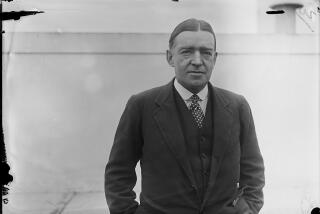Auction of S. Pole Relics Riles British Historians
- Share via
LONDON — The relics, now under glass at Christie’s auction house, serve as a poignant reminder of Britain’s golden era of polar exploration and the epic tales that made icons of Capt. Robert Scott and Sir Ernest Shackleton. Many of the objects, including the sled flag Scott flew at the South Pole in 1912, were recovered from the tent where Scott and two colleagues were discovered frozen in their sleeping bags. Scott’s team was the second to reach the Pole.
Christie’s plan to auction the items that once belonged to Scott and Shackleton--who failed in a separate quest to be first to the South Pole--has divided family members and upset British historians.
“It’s all very sad,” said David Wilson, whose great-uncle, Edward Wilson, froze to death with Scott.
Friday’s auction was announced only last week, angering British museums and historical societies, which have launched frantic fund-raising campaigns to compete in the bidding.
“With items of national significance, you would think institutions would be given the option of securing them for the nation,” said Richard Ormond, director of the National Maritime Museum.
John Heap, chairman of Britain’s Antarctic Heritage Trust, said he feared many of the items in Friday’s sale will end up in the United States.
The auction is expected to raise about $804,000 for the owners of the memorabilia, who include Scott’s grandson, R. Falcon Scott; Scott’s family trust; and relatives of Shackleton’s oldest son, Raymond.
Christie’s and the relatives involved declined to comment.
“The family is staying very much out of this and are feeling very jumped on,” said Bob Headland, archivist for the Scott Polar Research Institute in Cambridge, England. “I gather they have need for financing.”
The family feud became public last week when David Wilson and seven other relatives launched a campaign to stop the auction.
In a letter to the Times newspaper, the group said they “deeply regret the sale by some members of the Scott and Shackleton families.”
“There are about 22 pieces of national significance, half a dozen of which it would simply be a tragedy to see leave Britain,” said Wilson, 35, who lectures on Antarctic history. “It is like selling grave goods.”
Most of Scott’s relics haven’t been seen since 1913, when they were bundled into a suitcase and consigned to a bank vault for safekeeping by his son, Sir Peter Scott.
One year earlier, Scott’s five-man team had crossed the 89th parallel to the South Pole only to discover they had finished second to Norwegian Roald Amundsen.
Among the items up for auction are Scott’s Bible and parts for the Primus stove that gave his crew its last hot meal.
Shackleton’s mementos include a painted, silk Royal Standard bestowed by Queen Alexandra, and the liquid boat compass he used to navigate a lifeboat from his ice-bound ship Endurance to Elephant Island during the winter of 1915-16.
The National Maritime Museum is trying to acquire Shackleton’s compass and Scott’s flag before Friday’s sale.
Last year, after a public outcry, Christie’s withdrew several items from an Antarctic sale, including Scott’s leather sled straps from his 1902-04 expedition and a candle lantern used by Shackleton in 1907-09. The seller, who remained anonymous, donated the items to the Scott Polar Research Institute.
More to Read
Sign up for Essential California
The most important California stories and recommendations in your inbox every morning.
You may occasionally receive promotional content from the Los Angeles Times.










